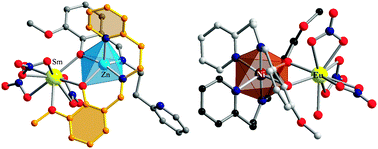Sixteen new 3d–4f binuclear complexes have been obtained using two Schiff-base ligands, Hvalampy and Hvalaepy, derived from the reaction of o-vanillin and 2-aminomethyl-pyridine or 2-(2-aminoethyl)-pyridine, respectively. Hvalaepy ligand: [Zn(valaepy)2Sm(O2NO)3]·CH3CN 1; [Ni(valaepy)2Eu(O2NO)3(H2O)]·CH3CN 2; [Ni(valaepy)2Gd(O2NO)3(H2O)]·CH3CN 3; [Ni(valaepy)2Dy(O2NO)3(H2O)]·CH3CN 4; [Ni(valaepy)2Ho(O2NO)3(H2O)]·CH3CN 5; [Cu(valaepy)2Eu(O2NO)3]·CH3CN 6; [Cu(valaepy)2Gd(O2NO)3]·CH3CN 7; Hvalampy ligand: [Zn(valampy)2Pr(O2NO)3]·CH3CN 8, [Zn(valampy)2Sm(O2NO)3]·CH3CN 9; [Zn(valampy)2Gd(O2NO)3]·CH3CN 10; [Zn(valampy)2Tb(O2NO)3]·CH3CN 11; [Zn(valampy)2Dy(O2NO)3]·CH3CN 12; [Zn(valampy)2Eu(O2NO)3]·CH3CN 13; [Ni(valampy)2La(O2NO)3(H2O)2]·2H2O 14, [Ni(valampy)2Sm(O2NO)3(H2O)2]·2H2O 15; [Ni(valampy)2Eu(O2NO)3(H2O)]·2CH3CN 16. The crystal structures of the sixteen compounds can be described as resulting from the coordination of two valaepy− (or valampy−) ligands to the 3d metal ions through two phenoxo oxygen atoms and nitrogen atoms, arising from the pyridyl and azomethynic groups. In all these compounds the 3d and 4f metal ions are bridged by the phenoxo oxygen atoms. The comparative analysis of the crystal structures shows several differences, which arise mainly from the stereochemical preference of the 3d metal ions. These ions arrange the two organic ligands in positions that favour or not the coordination of the methoxy groups to the lanthanide ions. The magnetic properties of compounds 2, 3, 4, 5, 7, 14, 15, and 16 have been investigated. The exchange interactions between NiII and GdIII in 3, and between CuII and GdIII in 7 were found to be ferromagnetic (JNiGd = 1.56 cm−1; JCuGd = 4.94 cm−1; H = −JSGdSM). For the 3d–4f binuclear complexes derived from the Hvalampy ligand (namely 8–13) the photoluminescence (PL) properties were investigated in the Vis spectral region. The results provide evidence for the relatively stronger antenna effect in 9 and 11 compared to 8, 12 and 13.


 Please wait while we load your content...
Please wait while we load your content...